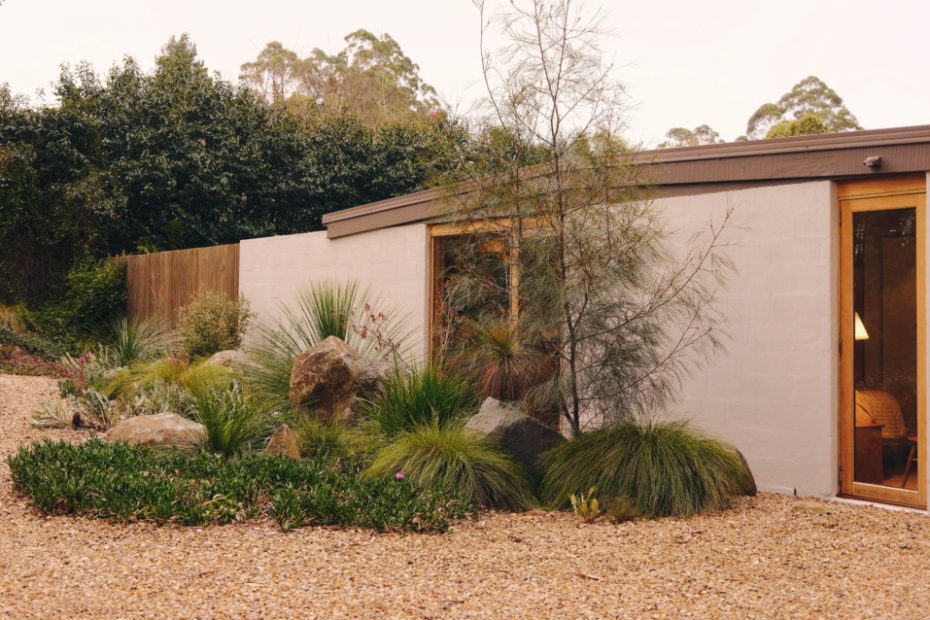How Trial + Error Lead To This Enchanting Hillside Garden
Gardens
The garden bed outside Louise and Ross’ bedroom window. Plants include Carpobrotus rossii (native pigface), Xanthorrhoea johnsonii (grass tree), Xanthorrhoea glauca (grass tree), Banksia petiolaris (creeping banksia) and Anigozanthos (Yellow gem kangaroo paws).
The front yard features a collection of natives: Dicksonia Antarctica (soft tree fern), Eucalyptus lacrimans (weeping snow gum) and Acacia leprosa (cinnamon wattle).
Louise Johnson and their dog Hogie. Timber arbour by Shaun Embleton. Tuscan aggregate pathways by Earthcore Landscapes.
Tuscan aggregate toppings paths lead to the garden studio where Louise works.
Acacia leprosa (scarlet blaze) and Tetratheca thymifolia (pink bells).
After clearing some sick trees from the garden, Louise and Ross planted Indigenous hakeas and Allocasuarina littoralis (Black she-oak) to provide food and habitat for the yellow-tailed black cockatoos that roam their neighbourhood.
The large flat rocks were excavated from the block and used as a feature in the garden.
‘I really enjoy the colours in this area,’ Louise says. ‘The beautiful shades of green and greeny-blue foliage are in harmony against the vibrant pops of yellow, red, pink and purple from the kangaroo paws, isopogon and native mint.’
The tall plants in the front yard create a screen from neighbours and the street.
This half-acre block in Mount Dandenong, Victoria, was a ‘blank canvas’ when designer Louise Jones and her husband Ross Fernando purchased the property in 2017.
About an hour from Melbourne, the 1980s Fasham Jonhson home is located opposite the Dandenong Ranges National Park.
And while the house was surrounded by giant 70-metre-tall eucalypt regnans (‘mountain ash’) — the tallest flowering trees in the world — the landscaping itself was originally limited to a handful of plants and grassy weeds.
‘We slowly started adding to the blank canvas when we moved in,’ Louise adds. ‘However, Ross and I really started to invest in our garden as a joint passion project over the lockdown years.’
Since then, the couple have painstakingly planned, designed, and planted the garden themselves, with help from Earthcore Landscapes to build the paths and garden beds.
‘Our garden has evolved through trial and error over the last seven and a half years. We have experimented with lots of plants and trees to find what can thrive in a cool climate with lots of rainfall,’ Louise says.
‘We’ve made family day trips to nurseries that specialise in native plants, and many of my birthday presents over the years have come in the form of grass trees — they’re expensive!’
Taking advice from friends and their favourite TV show, ABC’s Gardening Australia, Louise and Ross selected a variety of colourful flowering natives to attract wildlife: Anigozanthos (kangaroo paws), Mentha australis (native mint), boronias, and Brachyscome multifida (cut-leaf daisy).
Tuscan aggregate gravel helps define the driveway and pathways around the garden, accompanied by domes of Xanthorrhoea glauca (grass trees) and the blue-green foliage of Eucalyptus pauciflora (little snowman).
‘The garden bed in front of our bedroom window brings me the most joy, as we can observe the birdlife and insects the plants attract from our bedroom window,’ Louise adds. ‘I also enjoy the borderless garden bed style of this area, which allows the plants to spread and create an organic shape to the garden bed.’
Beyond this, the landscaping is very open and only has a few tall trees, after losing ‘a beautiful cluster’ of established Acacia and pine trees to a fungal disease a few years ago. They had to be removed by arborists, but the silver lining is that this allowed the garden to bask in more sunlight than ever before.
‘Our garden is much more layered, colourful, and it attracts an abundance of birdlife and insects, which is such a joyful sight to see,’ Louise adds.
